January/February 2024
By Daryl G. Kimball
(Nye County, Nevada)—When I visited the primary location for U.S. nuclear weapons testing, the Nevada Test Site, in September 1994 for the first time, whether the era of U.S. nuclear testing had come to a permanent end and whether a worldwide testing halt was possible were still open questions.
 Two years before that visit, bipartisan majorities in Congress, acting over the objections of the George H.W. Bush administration, approved legislation mandating a nine-month U.S. nuclear test moratorium in response to a Soviet testing moratorium declared in October 1991. In 1993, President Bill Clinton, following intensive interagency consultations, decided that further nuclear testing was not necessary. He would extend the U.S. nuclear test moratorium, establish the Stockpile Stewardship Program to maintain the arsenal without testing, and pursue multilateral negotiations for the Comprehensive Test Ban Treaty (CTBT) (see box).
Two years before that visit, bipartisan majorities in Congress, acting over the objections of the George H.W. Bush administration, approved legislation mandating a nine-month U.S. nuclear test moratorium in response to a Soviet testing moratorium declared in October 1991. In 1993, President Bill Clinton, following intensive interagency consultations, decided that further nuclear testing was not necessary. He would extend the U.S. nuclear test moratorium, establish the Stockpile Stewardship Program to maintain the arsenal without testing, and pursue multilateral negotiations for the Comprehensive Test Ban Treaty (CTBT) (see box).
Thirty years later, however, on a return visit to the site on November 30 at the invitation of senior leaders of the National Nuclear Security Administration (NNSA), I saw ample signs that although the dangerous era of U.S. nuclear weapons testing has ended, the site and the NNSA still have critical roles to play to ensure that nuclear explosive testing is not resumed by the United States or other countries. The visit, which included 12 other nongovernmental experts on arms control and nonproliferation, marked an unusual effort by NNSA leaders to demonstrate transparency about current activities at the site, most of which are now focused on maintaining the U.S. nuclear arsenal without nuclear testing. This new mission is underscored by the site’s new title, the Nevada National Security Site.
The visit’s aim was to provide firsthand information about how the former nuclear explosive test site “has been transformed into an experimental test bed and training ground for nonproliferation and national security missions,” according to the official invitation from Corey Hinderstein, the NNSA deputy administrator for defense nuclear nonproliferation. In addition to the Arms Control Association, participants represented the Carnegie Endowment for International Peace, Center for Arms Control and Non-Proliferation, Center for Strategic and International Studies, Federation of American Scientists, Harvard Kennedy School, Middlebury Institute of International Studies, National Academy of Sciences, Nuclear Threat Initiative, Open Nuclear Network, and Ploughshares Fund and included a French physics professor at the Hong Kong University of Science and Technology and a German physicist affiliated with the Institute for Peace Research and Security Policy at the University of Hamburg.
The Nevada Test Site in 1994
Carved out of tribal land seized from the Shoshone Nation of Native Americans,1 the Nevada Test Site was the location for 928 of 1,054 U.S. nuclear tests, including 100 atmospheric nuclear test explosions between 1951 and 1962 and another 828 tests performed underground.2 The last underground nuclear test, code-named Divider, was conducted in September 1992.
At the time of my 1994 tour, the Nevada Test Site Control Point facility, which was used to oversee and conduct nuclear tests and was located on the southern side of the site, was quiet but still operational and receiving authorized visitors. The 152-foot-tall test tower that was scheduled to house the next nuclear test explosion, dubbed Icecap, was clearly visible from the paved, two-lane highway that traverses the 1,355-square-mile site from south to north. The tower was still surrounded by mobile trailers stuffed with diagnostic equipment to monitor an underground nuclear blast. Icecap, a joint Los Alamos National Laboratory project with the United Kingdom, also demonstrated how the U.S. test site facilitated UK nuclear weapons development under the terms of the 1958 UK-U.S. agreement on cooperation on the uses of atomic energy for mutual defense purposes.
The Test Ban and Test Site Tensions
Three years after Clinton extended the U.S. test moratorium, diplomats at the Conference on Disarmament in Geneva concluded negotiations on the CTBT. To overcome an effort by India to block adoption of the text there, states supporting the treaty instead won approval from the UN General Assembly to open the pact for signature on September 24, 1996. Clinton was the first leader to sign it.
A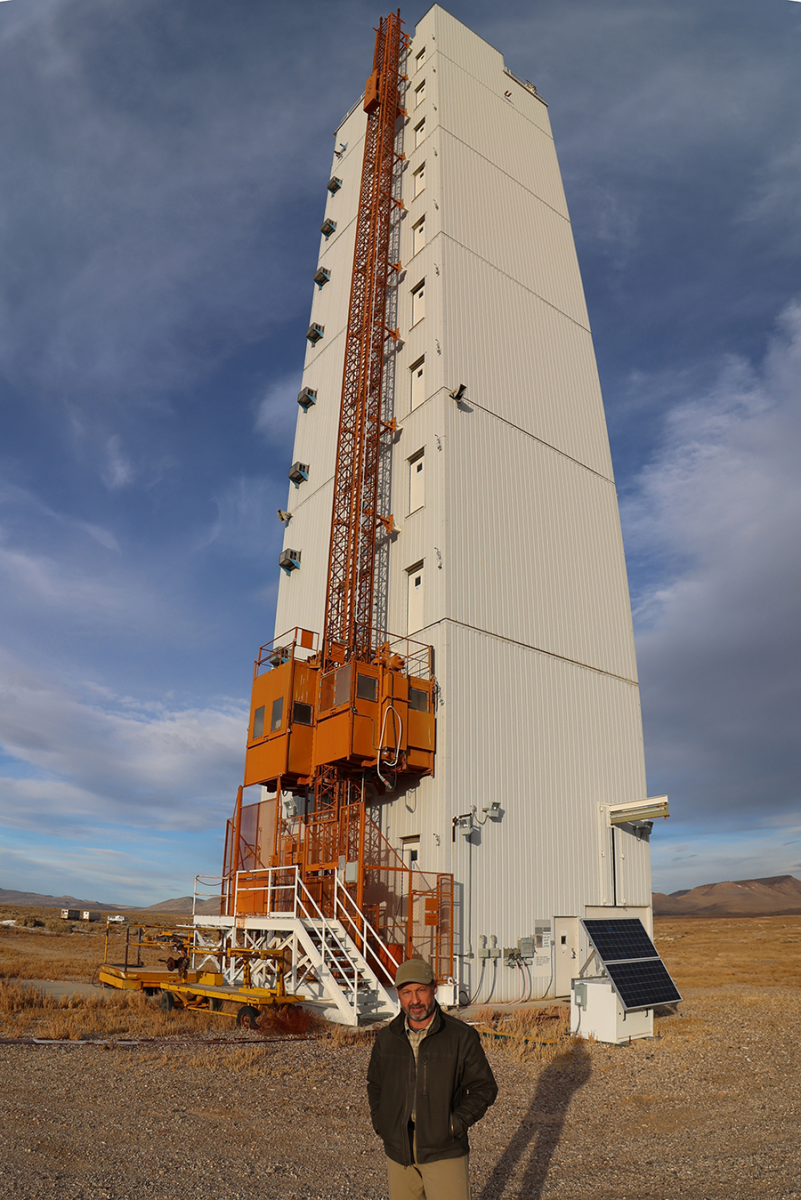 lthough not yet formally entered into force because the treaty requires that the United States and eight other specific states ratify it, the CTBT, which now has 187 signatories, has established a de facto halt to nuclear testing. It has become one of the most successful and valuable agreements in the long history of nuclear nonproliferation, arms control, and disarmament. Today, no state is conducting nuclear test explosions. North Korea is the only country to have done so in this century. Without the option to conduct nuclear tests, it is more difficult, although not impossible, to develop, prove, and field new warhead designs.
lthough not yet formally entered into force because the treaty requires that the United States and eight other specific states ratify it, the CTBT, which now has 187 signatories, has established a de facto halt to nuclear testing. It has become one of the most successful and valuable agreements in the long history of nuclear nonproliferation, arms control, and disarmament. Today, no state is conducting nuclear test explosions. North Korea is the only country to have done so in this century. Without the option to conduct nuclear tests, it is more difficult, although not impossible, to develop, prove, and field new warhead designs.
Yet, as with other nuclear risk reduction agreements, the CTBT is under stress due to inattention and worsening relations between nuclear-armed adversaries, as evidenced by Russia’s recent decision to withdraw its CTBT ratification to “mirror” the U.S. posture vis-à-vis the treaty. As recently as October 10, 2023, Russian Deputy Foreign Minister Sergei Ryabkov suggested that the United States might be carrying out preparations at its nuclear test site in Nevada.
Moreover, China, Russia, and the United States are racing to modernize their nuclear arsenals and continuing to engage in weapons-related research activities at their former test sites. As a result, some future subcritical nuclear experiment or chemical high-explosive detonation at one of these sites potentially could be mistaken or alleged to be a CTBT-prohibited supercritical nuclear explosion that produces a self-sustaining chain reaction.3 This might lead these or other countries to consider resuming full-blown nuclear explosive tests for the first time in decades.
Although the International Monitoring System established to verify CTBT compliance is fully operational and far more effective than originally envisioned, very low-yield nuclear test explosions still can be difficult to detect without on-site monitoring equipment or inspections, which will not be in place until the treaty formally enters into force.
During a speech in Vienna in June, NNSA Administrator Jill Hruby said her agency is “open to working with others to develop a regime that would allow reciprocal observation with radiation detection equipment at each other’s subcritical experiments to allow confirmation that the experiment was consistent with the CTBT.”4 Such a dialogue has not begun.
Hruby acknowledged that a primary reason why the NNSA has stepped up efforts to be more transparent about its activities at the Nevada site is to dispel allegations by Russian officials and others that the United States is preparing to resume nuclear explosive testing in violation of the CTBT, which bans all nuclear explosions at any yield.5
The Nevada Site Today
On my November visit to the former test site, little appeared to have changed on the surface. The serene, sagebrush-covered flatlands that stretch for miles are still pockmarked by hundreds of subsidence craters from past underground tests, which produced radioactive contamination that is embedded permanently under the desert floor.
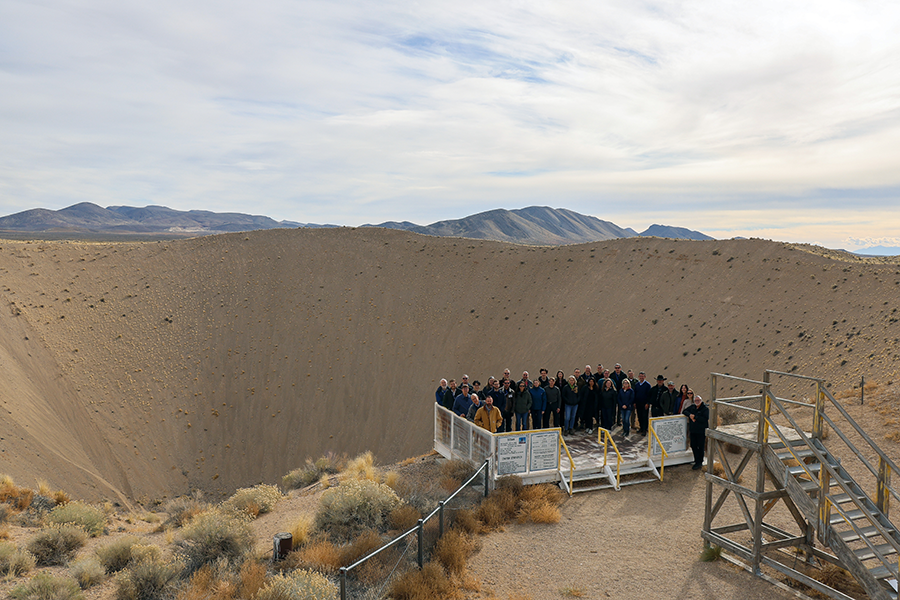 The massive Sedan Crater, the product of a misguided “peaceful nuclear explosions” program from 1961 to 1973, still stands out as a stunning reminder of the destructive power of nuclear weapons and the excesses of the Cold War-era nuclear weapons establishment. The program was intended to explore the use of nuclear bomb explosions to create canals and expand harbors and to stimulate natural gas production.6
The massive Sedan Crater, the product of a misguided “peaceful nuclear explosions” program from 1961 to 1973, still stands out as a stunning reminder of the destructive power of nuclear weapons and the excesses of the Cold War-era nuclear weapons establishment. The program was intended to explore the use of nuclear bomb explosions to create canals and expand harbors and to stimulate natural gas production.6
The crater, which is 1,280 feet in diameter and 320 feet deep, was produced by a 104-kiloton thermonuclear device detonated 635 feet underground. The explosion displaced and contaminated about 12 million tons of earth and sent radioactive fallout into the atmosphere. For all intents and purposes, much of the site will remain a national nuclear sacrifice zone for many decades to come.
Yet in many other ways, the NNSA transparency tour revealed how the site’s functions and activities have shifted significantly from a once-active nuclear weapons testing zone to a laboratory for experiments designed to safely maintain the U.S. nuclear arsenal without nuclear test explosions and for conducting nonproliferation research. As Marvin Adams, NNSA deputy administrator for defense programs, emphasized in a briefing preceding the visit, “[T]he United States has no technical need to conduct additional nuclear explosive tests and no plans to do so.”
The Icecap test tower, above a shaft drilled to a depth of 1,600 feet, still stands tall in Area 7 of Yucca Flats, but now serves mainly as a monument to the end of U.S. nuclear testing. Stripped of diagnostic cables for the test, it still houses a custom-made, cylindrical instrumentation rack, which would have weighed 350,000 pounds at the beginning of descent and 500,000 pounds by the time it was buried to contain the blast from the nuclear test explosion, which never took place.
Our delegation also explored one of the horizontal nuclear testing tunnels in Rainier Mesa that was excavated in the late 1970s and is known as the P-Tunnel. It was used for six separate nuclear weapons test explosions during the Cold War, but is now utilized for non-nuclear explosive experiments designed to improve capabilities for detecting potential foreign nuclear weapons test detonations. The P-Tunnel, in Area 12, was the site of an October 2023 nonproliferation experiment involving 16 metric tons of chemical high explosives and radiotracers to simulate the blast effects and the movement of gases that would be created by a prohibited nuclear explosion.
According to the NNSA, the experiment, which collected measurements using accelerometers, seismometers, infrasound sensors, electromagnetic sensors, chemical and radiotracer samplers, and meteorological sensors, helped “validate new predictive explosion models and detection algorithms.” Seismic data collected from these experiments are made available to researchers around the globe for analysis via the EarthScope Consortium website.
Although the October 18 verification experiment was designed to improve detection of low-yield nuclear test explosions, recent events suggest that it and similar non-nuclear experiments that produce explosions could create the potential for Russia or another nuclear-armed state to misconstrue or mischaracterize such activities as a CTBT-prohibited nuclear test explosions. In a coincidence of bad timing, the U.S. verification experiment took place the same day that the Russian parliament formalized the country’s decision to withdraw its ratification of the CTBT and as Russian President Vladimir Putin warned that Russia will only continue to refrain from nuclear testing if the United States does the same.
Two days after the NNSA experiment, the deputy speaker of Russia’s upper house of parliament called for an international assessment to determine whether the NNSA’s announced experiment was compliant with the CTBT. Ryabkov added that if the experiment was an underground explosion using chemical explosives and “if this information is true—it is presently being verified—this does not involve nuclear weapons testing, and this blast does not contradict either the U.S. moratorium on nuclear tests or the provisions” of the CTBT.
In keeping with the spirit of the treaty, the NNSA notified the Vienna-based Preparatory Commission for the Comprehensive Nuclear-Test-Ban Treaty Organization (CTBTO) in advance about the verification experiment. The organization’s IMS seismic stations detected a very small-scale, human-made explosion at the Nevada site that day. Regardless, these off-site seismic monitors alone cannot distinguish with high confidence between non-nuclear and nuclear explosions at very low yields.
After arriving at the P-Tunnel entrance, our delegation was outfitted with safety gear and escorted into the P-Tunnel for a briefing on the recent nuclear test verification experiment and future NNSA plans for similar experiments. The walking tour deep into the tunnel provided further confirmation that the October 18 verification experiment involved chemical high explosives.
In another sign of the site’s changing mission, our entourage went through Area 3 of Yucca Flats, where the NNSA stores equipment for a presidentially directed program that requires the agency to be ready to resume a nuclear explosive test within 36 months. The large, fenced-in outdoor storage yard was strewn with weather-worn equipment and massive spools of cable and wire and showed no signs of recent or planned activity. The large cranes once used to lower heavy diagnostic nuclear test assemblies into vertical tunnels are no longer at the site. Several experts in the delegation speculated that although an underground demonstration test of the kind reportedly discussed by senior Trump administration officials in 20207 could be conducted in less than 36 months, a fully instrumented, large-scale nuclear test explosion of a new or existing warhead design would take at least three years to tee up and that preparations for such a test would be detected easily by foreign governments and open-source imagery.
The delegation also spent nearly two hours at another key facility, known as U1A and located some 960 feet underground. This site, which was originally intended to be used for nuclear explosive testing, is now called the principal underground lab for subcritical experiments (PULSE).
Since the mid-1990s, the NNSA has conducted 33 subcritical experiments in the underground tunnels at the U1A complex primarily to improve the U.S. understanding of the physics of the aging plutonium in the cores of the Cold War-era nuclear devices that still comprise the U.S. nuclear arsenal. In a briefing, Adams emphasized that subcritical experiments are not “needed” to maintain confidence in the reliability and performance of the warheads in the U.S. nuclear arsenal but provide “important additional data on the plutonium in those warheads to support the continued certification of the reliability and performance well into the future without nuclear explosive testing.”
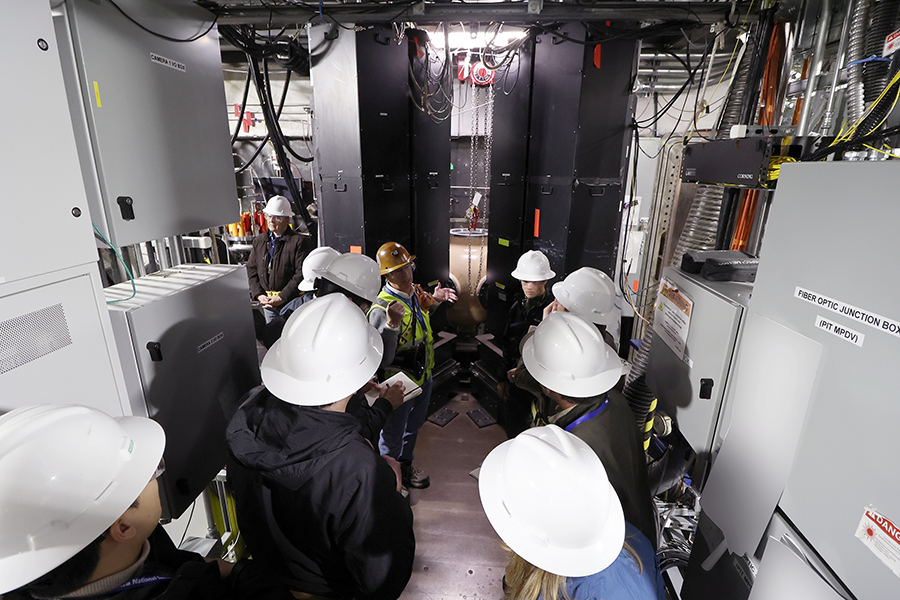 Originally, subcritical experiments were conducted in single-use alcoves mined into the walls or in vertical boreholes in the floor of the U1A complex. Our group walked over several of the metal seals that today cover the boreholes from some of these experiments. In more recent years, the experiments have been conducted in a robust confinement vessel located in an isolated “zero room,” which prevents the release of radiological material and conserves space in the underground facility.
Originally, subcritical experiments were conducted in single-use alcoves mined into the walls or in vertical boreholes in the floor of the U1A complex. Our group walked over several of the metal seals that today cover the boreholes from some of these experiments. In more recent years, the experiments have been conducted in a robust confinement vessel located in an isolated “zero room,” which prevents the release of radiological material and conserves space in the underground facility.
The delegation also was shown the main subcritical experiments machine now in use, called Cygnus, a pulsed X-ray radiography system designed to take at least two, time-separated radiographs of an explosive-driven experiment involving a small quantity of weapons-grade plutonium under dynamic shock. Each subcritical experiment takes approximately five years to conduct, from the initial planning to execution. Two more subcritical experiments are planned before mid-2024.
Tunnels under construction will house the more powerful Advanced Sources and Detectors Scorpius machine and the Neutron Diagnosed Subcritical experiments machine, dubbed ZEUS (Z-Pinched Experimental Underground System). These new machines, projected to cost more than $2 billion, will enable subcritical experiments that image the weapons-grade nuclear material with higher fidelity during multiple stages of the experiment. They are due to go online by 2030.
Hinderstein and Adams said that the NNSA continues to examine different technical approaches for potential confidence-building measures that could be applied to PULSE experiments and potentially subcritical experiments at other former test sites to provide independent confirmation that the experiments remain subcritical without revealing any classified information. Because subcritical experiments by design do not allow a self-sustaining nuclear chain reaction, or criticality, to occur, Adams suggested that the most reliable strategy for independent verification of the absence of a nuclear explosion would involve measuring for the absence of a self-sustained chain reaction. That would be indicated by a very rapid drop-off in the production of neutrons and gamma rays from the experiment.
Some independent experts, including two members of the delegation, said that because the yields of supercritical explosions are typically orders of magnitude larger than those of subcritical experiments, other technical methods also could be used to determine the amount of fission energy released by a contained, very low-yield nuclear experiment months or years later. This could be achieved, they suggested, by measuring the gamma rays from the radioactive decay of fission products and from transmutation products produced by the irradiation by fission neutrons.8
At this juncture, it is not clear whether the United States and the CTBT states-parties can find new ways to address concerns about potential very low-yield nuclear explosions at the former test sites in Russia, China, and the United States before the long-awaited entry into force of the CTBT. What is apparent is that the current NNSA leadership and the Biden administration are determined to show that the 1993 decision to extend the U.S. nuclear test moratorium “was not,” as Hruby said in September 2022, “a mere pause in our nuclear testing efforts but rather the bookend to the nuclear testing age.”9
|
Decisions Leading to the End of U.S. Nuclear Testing
President Bill Clinton’s July 3, 1993, decision to extend the U.S. nuclear test moratorium and seek to negotiate the Comprehensive Test Ban Treaty (CTBT) halted plans for the next nuclear test at the Nevada Test Site and put a permanent ban on nuclear testing within reach. Although the CTBT had been on the international nonproliferation agenda for decades, Clinton’s decision was precipitated by a crucial chain of events that forced a shift in policymakers' attitudes about nuclear testing.
In the Soviet Union, popular sentiment against nuclear testing grew stronger following a 1989 Soviet nuclear test in Kazakhstan that vented radioactivity into the atmosphere. A popular Nevada-Semipalatinsk Movement emerged to oppose further nuclear testing in Kazakhstan and elsewhere. Meetings and demonstrations were organized in many Kazakhstani and Soviet cities, including Moscow. The Soviets were forced to cancel 11 of 18 scheduled tests in 1989, and the Kremlin officially closed the main Soviet test site near Semipalatinsk in eastern Kazakhstan on August 29, 1991. Three months later, on October 5, Soviet leader Mikhail Gorbachev announced a unilateral, one-year testing halt and invited the United States to reciprocate.
In response, a bicameral, bipartisan group of U.S. lawmakers, including House Majority Leader Richard Gephardt (D-Mo.), Representative Mike Kopetski (D-Ore.), Senator Mark Hatfield (R-Ore.), and Senate Majority Leader George Mitchell (D-Maine), introduced legislation calling for a one-year U.S. moratorium. Backed by a strong citizen lobbying campaign, the legislation gained co-sponsors and momentum, especially after France joined Russia in declaring a nuclear test moratorium in April 1992 and the new Russian president, Boris Yeltsin, reiterated support
for the testing moratorium.
Another key development was the role of Senator Jim Exon (D-Neb.), a member of the Armed Services Committee who toured the Nevada Test Site earlier that year. By the summer, he proposed a compromise bill to establish a nine-month U.S. test moratorium; an end date for all U.S. nuclear tests of September 30, 1996; limits on the purpose and the number of any further tests to no more than 15; and a requirement for a plan to secure a global test ban treaty.
By September, the revised test moratorium legislation was approved by solid majorities in the House and Senate as part of a larger appropriations measurea over vigorous objections from President George H.W. Bush, who reluctantly signed it on October 3 and vowed to rescind it the following year. Bush lost the 1992 election to Clinton, who said during the campaign that he would pursue a global test ban treaty.
Once inaugurated, Clinton had just a few weeks to decide whether to extend the test moratorium. Initially, the White House considered a plan that would have allowed the resumption of U.S. nuclear testing by late 1993 and nuclear test explosions with yields of less than one kiloton as part of a global test ban regime. When The Washington Post broke the story about the draft plan in April 1993, test ban advocates and congressional leaders were furious.b They argued that congressional intent was to bring about a comprehensive test ban treaty, not one that would allow low-yield test explosions.
In the following weeks, as pressure from congressional leaders, newspaper editorial boards, and test ban campaigners to extend the U.S. test moratorium grew, the views within the Clinton administration shifted. Over the objections of the U.S. nuclear weapons laboratories and the Joint Chiefs of Staff, Clinton was persuaded by his new energy secretary, Hazel O’Leary; his science adviser, John Gibbons; and the Arms Control Disarmament Agency that further nuclear explosive testing was not necessary to maintain the safety and reliability of the nuclear arsenal and that he could and should extend the U.S. nuclear test moratorium and seek a comprehensive test ban treaty.—DARYL G. KIMBALL
a. Energy and Water Development Appropriations Act of 1993, 50 U.S.C. § 2530 (2003).
b. R. Jeffrey Smith, “White House Studies Nuclear Test Limits,” The Washington Post, April 30, 1993.
|
ENDNOTES
1. Princeton University, “Western Shoshone,” n.d., https://nuclearprinceton.princeton.edu/western-shoshone (accessed December 30, 2023).
2. National Nuclear Security Administration Nevada Field Office, “United States Nuclear Tests, July 1945 Through September 1992,” DOE/NV--209-REV 16, September 2015, https://www.osti.gov/servlets/purl/1351809.
3. Bureau of Arms Control, Verification, and Compliance, U.S. Department of State, “Scope of the Comprehensive Nuclear Test-Ban Treaty,” n.d., https://2009-2017.state.gov/t/avc/rls/212166.htm (accessed December 30, 2023).
4. National Nuclear Security Administration (NNSA), “Remarks by NNSA Administrator Jill Hruby at the CTBT: Science and Technology Conference 2023,” June 19, 2023, https://www.energy.gov/nnsa/articles/remarks-nnsa-administrator-jill-hruby-ctbt-science-and-technology-conference-2023.
5. “Managing an Arsenal Without Nuclear Testing: An Interview With Jill Hruby of the U.S. National Nuclear Security Administration,” Arms Control Today, December 2023.
6. Nevada National Security Site, “Sedan Crater,” NNSS-SEDN-U-0047-Rev01, May 2022, https://nnss.gov/wp-content/uploads/2023/04/NNSS-SEDN-U-0047-Rev01-1.pdf.
7. John Hudson and Paul Sonne, “Trump Administration Discussed Conducting First U.S. Nuclear Test in Decades,” The Washington Post, May 22, 2020.
8. Julien de Troullioud de Lanversin, Christopher Fichtlscherer, and Frank N. von Hippel, “Reducing Tensions Over Nuclear Testing at Very Low Yield,” Arms Control Today, November 2023.
9. See NNSA, “NNSA Administrator Jill Hruby Commemorates the 30th Anniversary of the Divider Nuclear Explosive Test,” September 23, 2022, https://www.energy.gov/nnsa/articles/nnsa-administrator-jill-hruby-commemorates-30th-anniversary-divider-nuclear-explosive.
Daryl G. Kimball is executive director of the Arms Control Association.
 The workers and technicians at the two chemical stockpile depots were nominated for their successful and safe completion of eliminating the last vestiges of the United States' once-enormous declared stockpile of lethal chemical munitions as required by the 1997 Chemical Weapons Convention.
The workers and technicians at the two chemical stockpile depots were nominated for their successful and safe completion of eliminating the last vestiges of the United States' once-enormous declared stockpile of lethal chemical munitions as required by the 1997 Chemical Weapons Convention.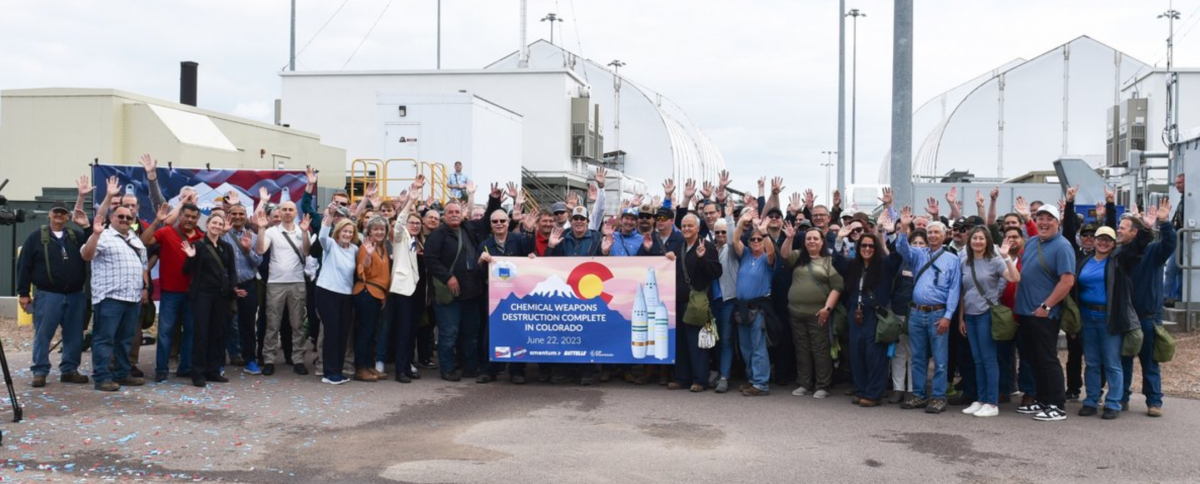





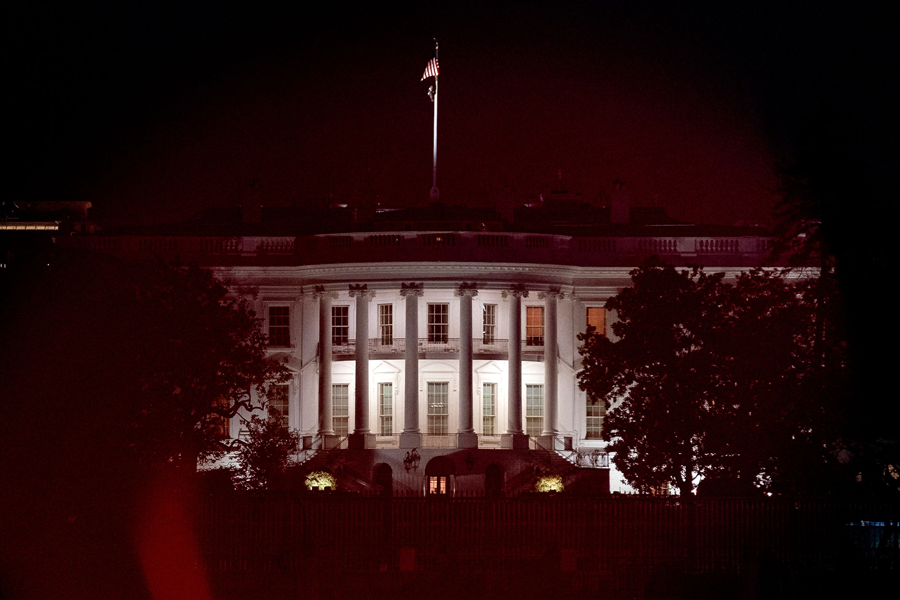 How the winner of the 2024 race will handle the evolving array of nuclear weapons-related challenges is difficult to forecast, but the records and policies of the leading contenders, President Joe Biden and former President Donald Trump, offer clues.
How the winner of the 2024 race will handle the evolving array of nuclear weapons-related challenges is difficult to forecast, but the records and policies of the leading contenders, President Joe Biden and former President Donald Trump, offer clues. Two years before that visit, bipartisan majorities in Congress, acting over the objections of the George H.W. Bush administration, approved legislation mandating a nine-month U.S. nuclear test moratorium in response to a Soviet testing moratorium declared in October 1991. In 1993, President Bill Clinton, following intensive interagency consultations, decided that further nuclear testing was not necessary. He would extend the U.S. nuclear test moratorium, establish the Stockpile Stewardship Program to maintain the arsenal without testing, and pursue multilateral negotiations for the Comprehensive Test Ban Treaty (CTBT) (see box).
Two years before that visit, bipartisan majorities in Congress, acting over the objections of the George H.W. Bush administration, approved legislation mandating a nine-month U.S. nuclear test moratorium in response to a Soviet testing moratorium declared in October 1991. In 1993, President Bill Clinton, following intensive interagency consultations, decided that further nuclear testing was not necessary. He would extend the U.S. nuclear test moratorium, establish the Stockpile Stewardship Program to maintain the arsenal without testing, and pursue multilateral negotiations for the Comprehensive Test Ban Treaty (CTBT) (see box). lthough not yet formally entered into force because the treaty requires that the United States and eight other specific states ratify it, the CTBT, which now has 187 signatories, has established a de facto halt to nuclear testing. It has become one of the most successful and valuable agreements in the long history of nuclear nonproliferation, arms control, and disarmament. Today, no state is conducting nuclear test explosions. North Korea is the only country to have done so in this century. Without the option to conduct nuclear tests, it is more difficult, although not impossible, to develop, prove, and field new warhead designs.
lthough not yet formally entered into force because the treaty requires that the United States and eight other specific states ratify it, the CTBT, which now has 187 signatories, has established a de facto halt to nuclear testing. It has become one of the most successful and valuable agreements in the long history of nuclear nonproliferation, arms control, and disarmament. Today, no state is conducting nuclear test explosions. North Korea is the only country to have done so in this century. Without the option to conduct nuclear tests, it is more difficult, although not impossible, to develop, prove, and field new warhead designs. The massive Sedan Crater, the product of a misguided “peaceful nuclear explosions” program from 1961 to 1973, still stands out as a stunning reminder of the destructive power of nuclear weapons and the excesses of the Cold War-era nuclear weapons establishment. The program was intended to explore the use of nuclear bomb explosions to create canals and expand harbors and to stimulate natural gas production.
The massive Sedan Crater, the product of a misguided “peaceful nuclear explosions” program from 1961 to 1973, still stands out as a stunning reminder of the destructive power of nuclear weapons and the excesses of the Cold War-era nuclear weapons establishment. The program was intended to explore the use of nuclear bomb explosions to create canals and expand harbors and to stimulate natural gas production. Originally, subcritical experiments were conducted in single-use alcoves mined into the walls or in vertical boreholes in the floor of the U1A complex. Our group walked over several of the metal seals that today cover the boreholes from some of these experiments. In more recent years, the experiments have been conducted in a robust confinement vessel located in an isolated “zero room,” which prevents the release of radiological material and conserves space in the underground facility.
Originally, subcritical experiments were conducted in single-use alcoves mined into the walls or in vertical boreholes in the floor of the U1A complex. Our group walked over several of the metal seals that today cover the boreholes from some of these experiments. In more recent years, the experiments have been conducted in a robust confinement vessel located in an isolated “zero room,” which prevents the release of radiological material and conserves space in the underground facility.